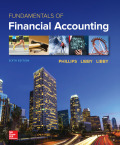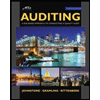
Fundamentals Of Financial Accounting
6th Edition
ISBN: 9781260159516
Author: PHILLIPS
Publisher: MCG
expand_more
expand_more
format_list_bulleted
Question
Chapter 5, Problem 20Q
To determine
To mention: The primary internal control objective of cash payments
Expert Solution & Answer
Want to see the full answer?
Check out a sample textbook solution
Students have asked these similar questions
Can you demonstrate the accurate steps for solving this financial accounting problem with valid procedures?
I need help with this financial accounting question using standard accounting techniques.
ezto.mheducation.com/ext/map/index.html?_con=con&external_browser=0&launchUrl=https%253A%252F%252Flms.mheducation...
CA
Chapter Five Problems i
Saved
7.5
2
points
eBook
The adjusted trial balance of Heritage Book Store and Supply Company as of November 30, 20X1, after the firm's first month of
operations, appears below.
Appropriate adjustments have been made for the following items:
a. Supplies used during the month, $11,600.
b. Expired rent for the month, $14,000.
c. Depreciation expense for the month, $3,800.
HERITAGE BOOK STORE AND SUPPLY COMPANY
Adjusted Trial Balance
November 30, 20X1
Account Name
Debit
Credit
Print
Cash
$ 92,300
Accounts receivable
15,248
Supplies
18,400
Prepaid rent
84,000
References
Equipment
Accumulated depreciation-Equipment
Accounts payable
110,000
$ 3,800
36,000
Frank Ross, Capital
167,348
Frank Ross, Drawing
16,000
Fees income
194,200
Depreciation expense-Equipment
3,800
Rent expense
14,000
Salaries expense
34,000
Supplies expense
11,600
Utilities expense…
Chapter 5 Solutions
Fundamentals Of Financial Accounting
Ch. 5 - Prob. 1QCh. 5 - Prob. 2QCh. 5 - Prob. 3QCh. 5 - Prob. 4QCh. 5 - Prob. 5QCh. 5 - What aspect(s) of the Sarbanes-Oxley Act might...Ch. 5 - Prob. 7QCh. 5 - What are the five components of an internal...Ch. 5 - Prob. 9QCh. 5 - Why is it a good idea to assign each task to only...
Ch. 5 - Prob. 11QCh. 5 - Prob. 12QCh. 5 - Prob. 13QCh. 5 - Prob. 14QCh. 5 - Prob. 15QCh. 5 - Prob. 16QCh. 5 - What is the primary internal control goal for cash...Ch. 5 - Prob. 18QCh. 5 - Prob. 19QCh. 5 - Prob. 20QCh. 5 - Prob. 21QCh. 5 - Prob. 22QCh. 5 - Prob. 23QCh. 5 - Prob. 24QCh. 5 - Prob. 1MCCh. 5 - Prob. 2MCCh. 5 - Prob. 3MCCh. 5 - Prob. 4MCCh. 5 - Which of the following internal control principles...Ch. 5 - Prob. 6MCCh. 5 - Prob. 7MCCh. 5 - Prob. 8MCCh. 5 - Prob. 9MCCh. 5 - Prob. 10MCCh. 5 - Prob. 1MECh. 5 - Prob. 2MECh. 5 - Prob. 3MECh. 5 - Prob. 4MECh. 5 - Prob. 5MECh. 5 - Prob. 6MECh. 5 - Prob. 7MECh. 5 - Prob. 8MECh. 5 - Prob. 9MECh. 5 - Prob. 10MECh. 5 - Prob. 11MECh. 5 - Prob. 12MECh. 5 - Prob. 13MECh. 5 - Prob. 14MECh. 5 - Prob. 15MECh. 5 - Prob. 16MECh. 5 - Identifying Internal Control Principle and...Ch. 5 - Prob. 2ECh. 5 - Prob. 3ECh. 5 - Prob. 4ECh. 5 - Prob. 5ECh. 5 - Prob. 6ECh. 5 - Reporting Cash, Cash Equivalents, and Restricted...Ch. 5 - Prob. 8ECh. 5 - Prob. 9ECh. 5 - Prob. 10ECh. 5 - Prob. 1CPCh. 5 - Prob. 2CPCh. 5 - Prob. 3CPCh. 5 - Prob. 4CPCh. 5 - Prob. 1PACh. 5 - Prob. 2PACh. 5 - Prob. 3PACh. 5 - Prob. 4PACh. 5 - Prob. 1PBCh. 5 - Prob. 2PBCh. 5 - Prob. 3PBCh. 5 - Prob. 4PBCh. 5 - Recording Transactions and Adjustments,...Ch. 5 - Finding Financial Information Refer to the...Ch. 5 - Comparing Financial Information Refer to the...Ch. 5 - Ethical Decision Making: A Real-Life Example When...Ch. 5 - Ethical Decision Making: A Mini-Case You are an...Ch. 5 - Accounting for Cash Receipts, Purchases, and Cash...
Knowledge Booster
Similar questions
- Can you help me solve this general accounting problem with the correct methodology?arrow_forwardPreston Manufacturing uses a standard costing system that allows 2.5 pounds of direct materials for one finished unit. During August, the company purchased 35,000 pounds of direct materials for $175,000 and manufactured 12,600 finished units. The standard direct materials cost allowed for the units manufactured is $126,000. The performance report shows that Preston has an unfavorable direct materials usage variance of $5,040. Also, the company records any price variance for materials at time of purchase. The number of pounds of direct materials used to produce August's output was__ pounds. Helparrow_forwardWhat is the conversion cost per equivalent unitarrow_forward
arrow_back_ios
SEE MORE QUESTIONS
arrow_forward_ios
Recommended textbooks for you
 Cornerstones of Financial AccountingAccountingISBN:9781337690881Author:Jay Rich, Jeff JonesPublisher:Cengage LearningPrinciples of Accounting Volume 1AccountingISBN:9781947172685Author:OpenStaxPublisher:OpenStax College
Cornerstones of Financial AccountingAccountingISBN:9781337690881Author:Jay Rich, Jeff JonesPublisher:Cengage LearningPrinciples of Accounting Volume 1AccountingISBN:9781947172685Author:OpenStaxPublisher:OpenStax College Intermediate Accounting: Reporting And AnalysisAccountingISBN:9781337788281Author:James M. Wahlen, Jefferson P. Jones, Donald PagachPublisher:Cengage Learning
Intermediate Accounting: Reporting And AnalysisAccountingISBN:9781337788281Author:James M. Wahlen, Jefferson P. Jones, Donald PagachPublisher:Cengage Learning Auditing: A Risk Based-Approach to Conducting a Q...AccountingISBN:9781305080577Author:Karla M Johnstone, Audrey A. Gramling, Larry E. RittenbergPublisher:South-Western College Pub
Auditing: A Risk Based-Approach to Conducting a Q...AccountingISBN:9781305080577Author:Karla M Johnstone, Audrey A. Gramling, Larry E. RittenbergPublisher:South-Western College Pub

Cornerstones of Financial Accounting
Accounting
ISBN:9781337690881
Author:Jay Rich, Jeff Jones
Publisher:Cengage Learning

Principles of Accounting Volume 1
Accounting
ISBN:9781947172685
Author:OpenStax
Publisher:OpenStax College



Intermediate Accounting: Reporting And Analysis
Accounting
ISBN:9781337788281
Author:James M. Wahlen, Jefferson P. Jones, Donald Pagach
Publisher:Cengage Learning

Auditing: A Risk Based-Approach to Conducting a Q...
Accounting
ISBN:9781305080577
Author:Karla M Johnstone, Audrey A. Gramling, Larry E. Rittenberg
Publisher:South-Western College Pub